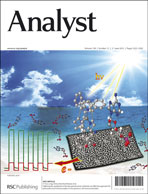A simple, cost-efficient, sensitive and selective fluorescence sensor is developed for sequence-specific recognition of duplex DNA (ds-DNA) in vitro using metal–organic framework (MOF) as the sensing platform. N,N-Bis(2-hydroxy-ethyl)dithiooxamidatocopper(II) (H2dtoaCu) was chosen as the example MOF, because it strongly chemisorbs the dye-labeled probe TFO (triplex-forming oligonucleotide), and quenches fluorescence from the dye. In the presence of target ds-DNA (the PPT of HIV RNA, a 16-bp ds-DNA sequence), the TFO could interact with the major groove in ds-DNA (via Hoogsteen hydrogen bonding) to form a rigid triplex structure, resulting in fluorescence recovery. The enhanced fluorescence signal has a relationship with the ds-DNA concentration, the detection limit is as low as 1.3 nmol L−1 (S/N = 3) with good selectivity, which is lower than that based on a graphene oxide platform and electrochemical-DNA sensor.
You have access to this article
 Please wait while we load your content...
Something went wrong. Try again?
Please wait while we load your content...
Something went wrong. Try again?


 Please wait while we load your content...
Please wait while we load your content...